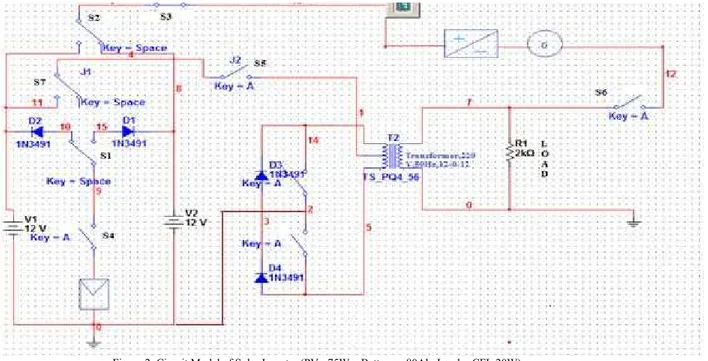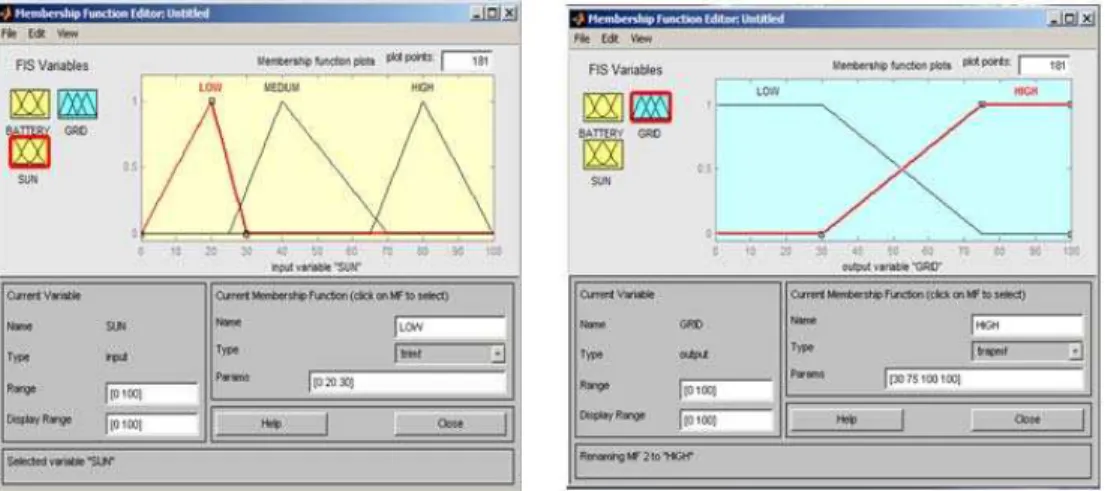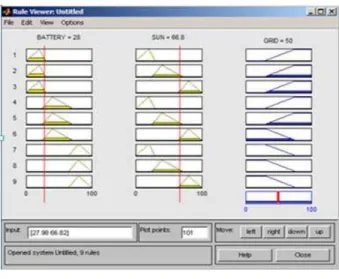A Novel Design of Sustainable Solar Home
Power Lighting: A Case Study with Indian
Restaurant
Dr S.N. SINGH
Electronics & Communication Engineering
National Institute of Technology, Jamshedpur(India) - 831014
NISHA KUMARI
Electronics & Communication Engineering
National Institute of Technology, Jamshedpur (India) – 831014
Abstract:
Indian restaurant popularly known as eatery house /dhabas uses grid assisted, battery backed up inverter for continuous supply for lighting. In case of prolonged grid cut off, battery do not get charged to its full strength and seizes to function before time. In this study, a novel design of solar inverter has been proposed which eliminate the grid dependability and provide 24 hour power to these dhabas which are pollution free and utilizes solar radiation as fuel which is abundantly available. The PWM technology is used to charge the battery of inverter in sharing mode with grid supply, due to varying PV energy throughout the day(sun hour), and use of dual battery used for continuous supply as well as storing charge alternatively are unique features to maintain sustainability. The impact study carried out have resulted satisfactory performance. The implementation of solar power lighting technology against conventional k- oil lamp increases sale figure resulted in uplifting socio-economic status of restaurant owners also.
Keywords: Solar inverter, PWM charger, Fuzzy control, MATLAB, Grid etc
1. INTRODUCTION
Electricity reaches only a limited portion of the world’s population. More than 1.6 billion people worldwide lack connection to an electrical network. Candles and kerosene / oil lamps are still some of the most common basic options for lightning, with dry cells and automotive batteries used to power radios, televisions and small apliances.These sources are low quality, cumbersome expensive and often dangerous, but they are the only available option to rural families, resturarents small farmers, business, offices and institutions. The solar home lighting system, a wireless solar power system originally designed for rural and pen-urban customer in India, enables families to improve their productivities generating activities in the evening while their children can have better light for studying. Many standalone and hybrid power supply system have been developed by many authors in the past but sustainability and cost effectiveness have not been considered and thought much. In the proposed scheme, sustained power supply using PV energy as a primary source have been modeled and developed. Its impact study has been carried out as a case study in Indian restaurant popularly known as ‘ Eatery house/Dhabas’ located in almost all common places like parks, offices courts, industries, cinema halls, markets, bus/railway stations, colony etc. These dhabas, owned by potential youth of village or town, serve food items to customers throughout day and late hours of night.
2. SYSTEM MODEL DESCRIPTION
The solar home light model consists of the following units as shown in Figure (1) namely:
Solar PV module
Battery charger
Battery bank
Figure 1: Block Diagram of Proposed Solar (PV) Power Supply Scheme
2.1.Solar Photovoltaic module
A solar photovoltaic module is the basic element of each photovoltaic system. It converts solar energy into DC electricity when sunlight falls on its surface. This DC signal is converted to AC by inverter to meet AC load requirement of houses.
2.2.Solar inverter cum charge controller with intelligent logic control
Solar Inverter converts DC power from battery, charged from PV source, to AC power compatible with the utility and AC loads. This unit consists of solar inverter cum charge controller with intelligent logic which controls the charging of battery from solar or mains or both with solar as priority in sharing mode. This system monitors the battery charging status and accordingly decides to charge the battery either from solar or from mains or both in sharing mode.
2.3. Battery
A device that converts the chemical energy contains in its active material directly into electrical energy by means of an electrochemical reaction. Low maintenance tubular type batteries are provided with the system. Battery deep discharge, over charge protections are incorporated inside the solar converter. The battery charge is controlled through constant charging regulator module using PWM technology. Design incorporate auxiliary source i.e. grid which charges the battery in sharing mode with solar (PV) as first priority to charge battery attaining full voltage i.e, 13.4V.
3. WORKING PRINCIPLE
Figure 2: Circuit Model of Solar Inverter (PV =75Wp, Battery = 80Ah, Load = CFL 20W)
4. DESIGN OF SYSTEM MODULE
The system module design includes PV module, Charging unit and Inverter etc.
4.1.PV Module design:
The PV module design has been computed on the basis of load consumption of an eatery house/dhabas .The data acquired is tabulated and shown in Table 1.
Table 1: Load Profile S.
No
Load Profile (Watt x Hour x Number)
Peak Consumption (Wh) 1 10 W CFL *4 Hr *2(No) 80 2 40 W Fan * 4 Hr * 3(No) 480
3 Electrical Appliance(s) 1040 Total 2100
The PV design is based on 50% sharing with grid supply (Equation (1) and Equation (2)) PV Rating (50% Sharing)
P
. . =112.9 Wh (1)
Where,
1.5 = Safety Factor,
6.2 = Sun Hour (hr), ½ = 50 % sharing
No. of module P . =2(approx.)
(2)
4.2. Battery Capacity
The battery capacity is designed (Equation.3 and Equation.4) to feed the load requirement of house.
Battery Capacity L
B =175Ah = 180Ah (2x80Ah)
(3)
4.3. Inverter design
(4) 4.4. Control Strategy: Fuzzy algorithm for sharing of source current for charging
Fuzzy logic control has been used to charge the battery on getting its inputs sun radiation and current battery status. The output variable of this controller is the adaptive duty cycle i.e. sharing time interval of grid/DG or turn-on time period of the battery. Since these input parameters represented by membership function are to be fuzzified, equation (5), the max-min method of fuzzification, is used to set the fuzzy rules of the controller.
μ = (α1 μ1) (α2 μ2) (5)
Where,
μ1 and μ2 are membership functions
α1 andα2 are variables
Fuzzy algorithm has been changed back by using the method of defuzzification. Subsequently, the approximate centre of gravity (COG) method, supposed to be the most accurate method to get a crisp value i.e. sharing time, is used for the defuzzification, as shown in equation (6).
COG ∑∑ µ
µ
(6)
Where,
μi = action of the ith rule would dictate μ(i) = truth of rule
Input Variable:
1) Battery
Critical s: trimf (0 20 30) Base: trimf (25 40 70) Peak: trimf (65 80 100)
2) Sun Radiation Low: trimf (0 20 30) Medium: trimf (25 40 70) High : trimf (65 80 100)
3) Output variable:
Grid Low: trapmf (0 30 75) Grid High: trapmf (30 75 100)
A CASE STUDY: Actual Calculation for operational time in % for the given battery status (28%) and sun radiation (66.8%) has been given below:
Rules fired are 2, 3, 5 and 6
Strength of rule 1 : [L (0.165) M(0.165)] = 0.165
Strength of rule 2 : [L (0.165) H(0.245)] = 0.165 Strength of rule 3 : [L (0.165) H(0.245)] = 0.165 Strength of rule 4 : [M (0.245) H(0.245)] = 0.245
Where,
L: Critical (Low), M: Base (Medium), H: Peak (High)
Output Variable using CENTROID Method (Equation 6):
. . . .
= 50.067
5. RESULTS AND DISCUSSION
5.1.Validation of Control strategy with MATLAB software
The computed data has been validated with MATLAB software as shown in Figure (3),(4),(5) and (6)
Figure 3: Fuzzy Rules used in Simulation
Figure 5: Rule Viewer 6. Performance Evaluation of System
The prototype unit developed for 300W has been tested in laboratory and the following tests has been carried out
6.1.Charging of Battery
The charging current of Battery (80Ah) has been monitored for an autonomy period of one day(10hr) and depicted in graph as shown in Figure 6.
6.2. Power Sustainability
The power sustainability has been maintained by assigning priority loads. Critical loads were assigned top priority and other loads in descending order of their use. Power monitoring data throughout day (24 Hour) for Battery status 10.4 -13.8V has been observed.
Figure 6: Battery charging voltage
6.3. Sensitivity Analysis
6.3.1. PV power delivery and saving in electricity
The system has been tested under varying climatic condition throughout the year. The power delivered by PV system, as monitored, has been depicted in graph (Fig. 8).
6.3.2. Efficiency
Figure 7: Graph showing variation (%) in Saving and variation of load efficiency
6.3.3. Comparative study
A comparative study has been carried out between the proposed system and conventional systems like PV stand alone, PV-grid and Grid Battery and results were recorded.
6.3.4. Working Economy
The cost of the system for 750VA/300 Watt is computed and cost of system has been computed (Table 2).
7. IMPACT OF SOLAR INVERTER SYSTEM: A CASE STUDY
A solar powered dhaba (Figure 10) located in the mid city of Jamshedpur was adopted to study the impact of design model of power supply to provide light during evening. Petromax and Kerosene oil lamps were being used in these dhaba during grid failures (load shedding) which were causing inconvenience to customers and owner during evening hours. The conventional inverter was used to attract the customer but frequent failure of grid could not charge the battery to its fullest strength and thus sustainability of power could not be maintained. This could become possible with the use of solar inverter only. During investigation it was observed that most of customers were leaving the place due to inadequate light and safety. The impact of solar inverter could be able to bring benefits like:
a) Pollution free atmosphere
b) Saving in budget towards the cost of fuel(kerosene oil) To maximum value of around Rs 300 per month. c) Reduction in medical expenses
d) Food quality improved
e) Services hour increased up to late hour f) Safety etc.
Table 2: Cost Calculation of proposed system S.
No Item(s) Rating
Cost (Rs)
1 PV Module 2*75 WP Rs 15,000
2 Battery 150 Ah Rs 10,000
3 SOLAR Inverter 750 VA Rs 5,000
4 Maintenance per year Rs 1,000
Fig.8: Solar dhaba
8. CONCLUSION AND FUTURE WORK
In this project study, the design of a novel scheme of solar inverter has been developed with an objective to save grid power and creating a pollution free environment. The performance characteristic has been carried out and found to be well suited to these dhabhas. The technology used in this project may bring a green revolution in electrification of remote houses running dhabhas or charging station. The cost effectiveness of inverter and related accessories will attract more potential youths to adapt and run their own shops.
REFERENCES
[1] J.S.R. Jang, C.T. Sun, E. Mizutani, “Neuro-Fuzzy and Soft-Computing: A computational approach to learning and machine intelligence”, Prentice Hall of India pp 13-63 (1997).
[2] Shehu, S and George Vachtsevanos,”Robust Stability of Fuzzy Logic Control Systems”. American Control Conference (.1995).
[3] Tanaka, K and Ugeno,”Stability Analysis and Design of Fuzzy Controller”. Fuzzy sets and systems (1992).
[4] Juang, C.F, Lin C.T,”A Recurrent Self-Organizing Neural Fuzzy Inference Network”, IEEE Trans. Neural Networks 10, pp. 828-845(1999).




